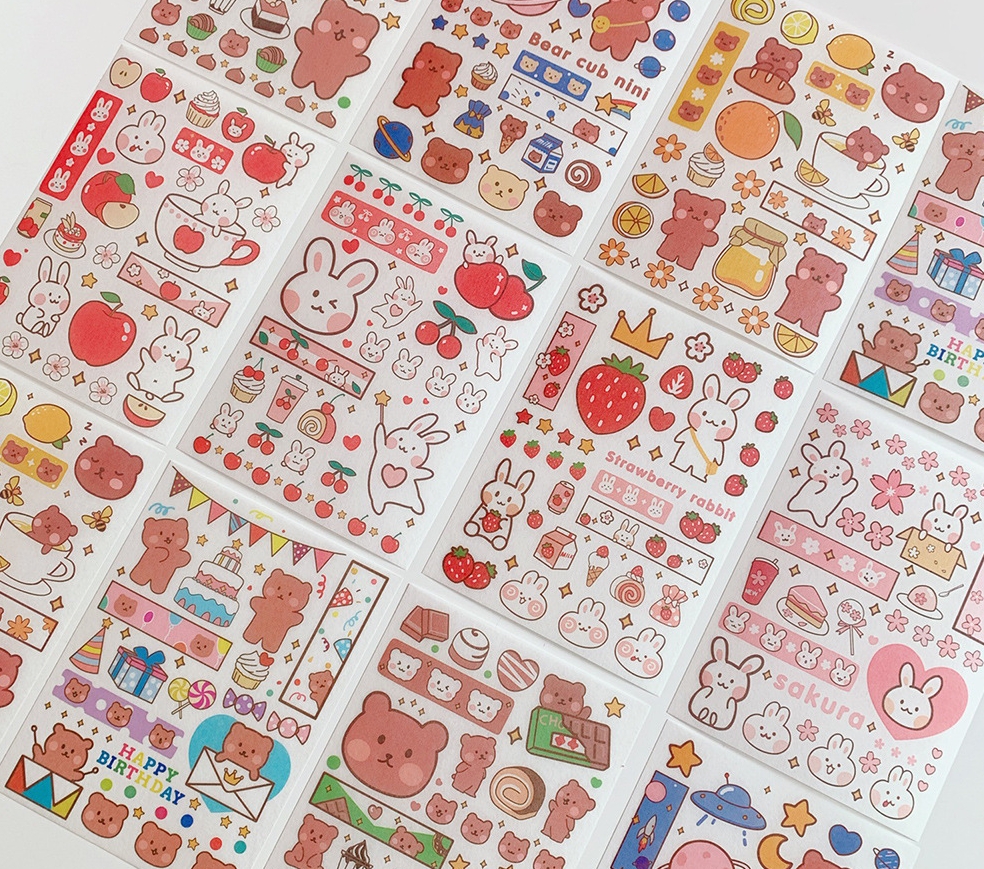Sticker printing:
Stickers are adhesive-backed paper that feature various images and photos printed onto them. They are commonly seen on the market and can be affixed to various products, making them widely used and a major focus product in the printing industry. They come in different patterns, colors, and varieties, and most are disposable.
Adhesive printing:
In terms of printing methods, adhesive printing typically employs screen printing. In recent years, due to the development of offset printing technology, adhesive printing has also adopted offset printing methods. It requires film output and plate making before printing. • In terms of post-press processing techniques, necessary cutting is required. When there are special design requirements, some special processing techniques will be added, but generally, the complexity is not high. For some roll-to-roll adhesive printing machines, processes such as printing, laminating, bronzing, and die-cutting can be completed in one go.

Production process of adhesive stickers:
Roll up
1. Intermittent: There is no tension change when the roll paper is unwound, so no adjustment is required. It is applied to flat-bed and rotary label machines, where the unwinding speed is slow. Since such equipment lacks a paper positioning and correction device, it is required that the end face of the roll paper be clean and tidy to ensure accurate overprinting during printing.
2. Continuous type: It is applied to rotary round-press-round label machines. Due to the tension variation of the paper when the diameter speed of the roll changes, this device is equipped with automatic or manual tension control mechanisms, as well as a roll paper correction device, to ensure smooth paper feeding and printing quality.
Hot stamping
Flatbed: Applied to round-flat and flat-flat label machines, with low speed.
Rotary-to-rotary: applied to rotary-to-rotary label printing machines, it has fast speed and can perform continuous bronzing. However, it is rarely used, and the gold printing process is generally used instead of bronzing.
Printing
Flatbed printing: suitable for printing on small areas with simple patterns, such as price tags, barcodes, etc.
Round-pressing: suitable for label printing with solid areas and general patterns, and capable of simple color halftone printing.
Rotary printing is suitable for all types of patterned label printing, especially for high-end color halftone label printing.
UV printing: Among the above three printing methods, all of them can print thin film adhesive materials after being combined with UV drying.
First, apply bronzing, then proceed with printing
On equipment without UV drying, using regular ink has the disadvantage of limiting the design of printed patterns.
Print first, then bronzing
Applied to equipment equipped with UV drying devices, the ink dries quickly and is then bronzed. The bronzing pattern can be designed freely, without being limited by the ink. It is suitable for printing high-end labels and represents an advanced production process. Jiarunlong Printing adopts advanced foreign equipment to ensure more precise and effective printing.
Light up
On-site glazing: Apply a layer of varnish on the surface of the ink, aiming to protect the ink layer, prevent moisture and water, and enhance surface gloss. It can replace the laminating process and employs UV drying method.
Laminated film
Laminating on paper or film materials aims to protect the ink, provide waterproofing and moisture resistance, enhance label strength, and add a three-dimensional effect to the pattern. Laminating is divided into laminating with backing paper and laminating without backing paper. Due to the lower cost of the latter, it is currently widely adopted. According to process requirements, there are two types of laminating: composite transparent film and matte film, with the former being more commonly used.
Punching holes
The application is not widespread, primarily used for labels printed by computers. The requirement is to punch positioning drive holes on both sides of the label, or for labels used on price guns, a hole is required to be punched in the middle of the label for positioning and driving purposes.
Die cutting
The die-cutting process for adhesive labels employs a semi-cut-through technique, meaning that only the surface material is cut through while the backing paper remains intact. There are two processing methods:
Flatbed die-cutting is suitable for various label printing machines and manual plate making, with low cost and short plate making cycle. However, its low viscosity makes it suitable for short-run printing processes. Currently, almost all domestic label factories adopt flatbed die-cutting. Another type is rotary die-cutting, which is applied to rotary label equipment. It has fast speed and high die-cutting viscosity, making it suitable for long-run jobs. However, its disadvantage is high plate making cost and long cycle. Currently, the die-cutting rollers of domestic manufacturers are generally processed abroad.
Delivery paper
It can be roughly divided into cutting and paper collection, and folding and paper collection.
Precautions for sticker printing:
1. When printing adhesive stickers, the choice of adhesive is crucial to ensure good sticking effect, which is also an important factor affecting the quality of adhesive stickers. Jiarunlong Printing uses imported adhesive from a certain country, which effectively reduces or even
eliminates the problems caused by adhesive.
2. The neatness of adhesive stickers: When printing stickers, the neatness of the product should be maintained, mainly ensuring that the edges are neat and intact. Otherwise, it will affect the quality of the adhesive printing product.
